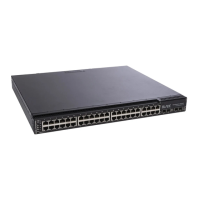© Copyright IBM Corp. 2011 145
Chapter 12. Virtualization
Virtualization allows resources to be allocated in a fluid manner based on the logical
needs of the data center, rather than on the strict, physical nature of components.
The following virtualization features are included in IBM Networking OS 6.8 on the
RackSwitch G8000 (G8000):
•
Virtual Local Area Networks (VLANs)
VLANs are commonly used to split groups of networks into manageable
broadcast domains, create logical segmentation of workgroups, and to enforce
security policies among logical network segments.
For details on this feature, see “VLANs” on page 93.
•
Port trunking
A port trunk pools multiple physical switch ports into a single, high-bandwidth
logical link to other devices. In addition to aggregating capacity, trunks provides
link redundancy.
For details on this feature, see “Ports and Trunking” on page 107.
•
Virtual Link Aggregation (VLAGs)
With VLAGs, two switches can act as a single logical device for the purpose of
establishing port trunking. Active trunk links from one device can lead to both
VLAG peer switches, providing enhanced redundancy, including active-active
VRRP configuration.
For details on this feature, see “Virtual Link Aggregation Groups” on page 159
•
Stacking
Multiple switches can be aggregated into a single super-switch, combining port
capacity while at the same time simplifying their management. IBM N/OS 6.8
supports one stack with up to six switches.
For details on this feature, see “Stacking” on page 147.
•
VMready
The switch’s VMready software makes it virtualization aware. Servers that run
hypervisor software with multiple instances of one or more operating systems
can present each as an independent virtual machine (VM). With VMready, the
switch automatically discovers virtual machines (VMs) connected to switch.
For details on this feature, see “VMready” on page 165.
N/OS virtualization features provide a highly-flexible framework for allocating and
managing switch resources.

